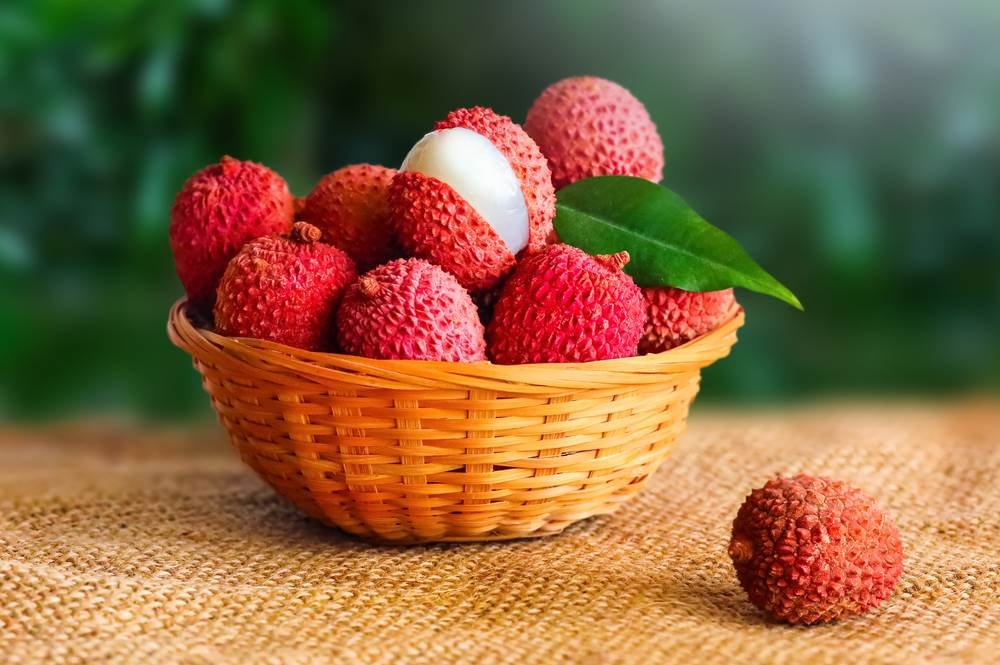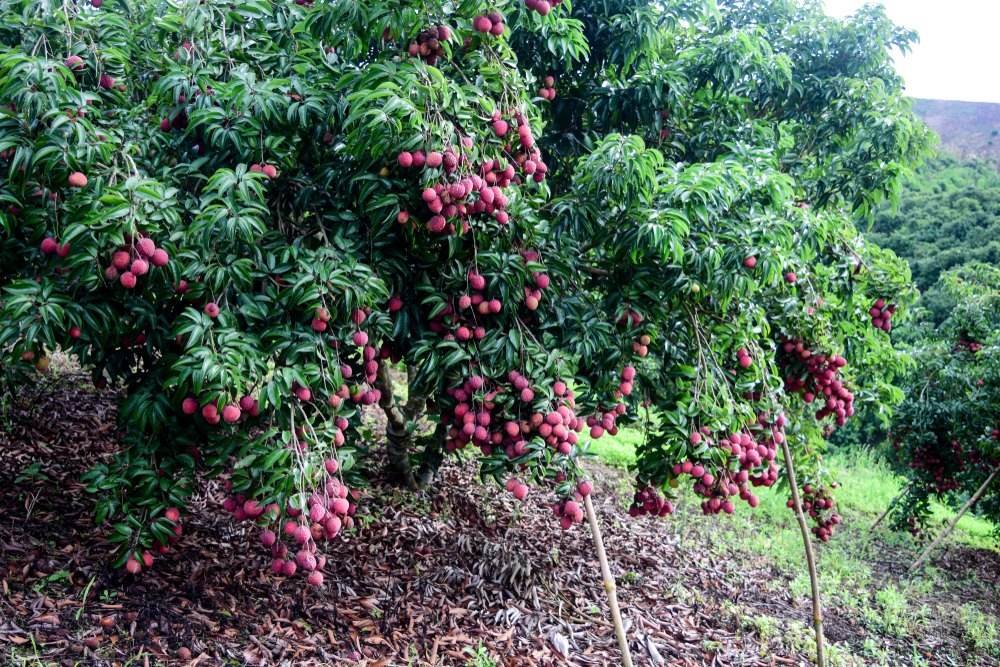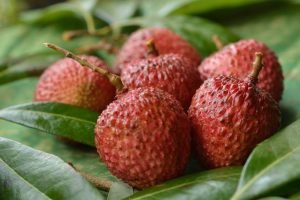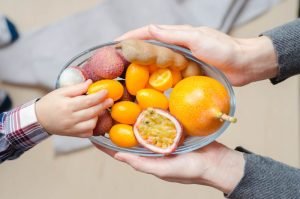
What is Lychee Fruit?
Tropical Lychee fruit is native to China and Southeast Asia. The name Lychee comes from the Greek word lyskythos meaning “sweet” therefore it is known for its sweet taste and soft flesh. They have been cultivated since ancient times and were introduced to Hawaii around 1750. Today, Lychees are grown commercially in many countries around the world, including China, India, Indonesia, Malaysia, Thailand, Vietnam, Philippines, Taiwan, Japan, Korea, Australia, New Zealand, Hawaii, etc.
The lychee fruit is a small, round, yellow-orange fruit that grows inside a hard shell. Inside the shell is a single seed surrounded by a thick layer of white pulp. The fruit is rich in vitamin C, fiber, protein, and iron.
There are two types of lychee fruit: sweet (or sour) and bitter. Sweet lychees have a thick, fleshy outer covering called the pericarp, while bitter ones do not. Both types of lychees are edible and delicious.
Nutrition Facts (per 100g)
| Energy: 50 Kcal/ 20 KJ | Fat: 0 g | Carbohydrates 19 g |
| Fiber 2 g | Protein 1 g | Sodium 0 mg |
| Vitamin A 0 IU | Vitamin C 0 mg | |
| Calcium 0 mg | Iron 0 mg |
Lychee fruit tree
The lychee tree (also known as the guava) is native to tropical regions of Central and Southern America, the Caribbean, and Mexico. A small fleeting tree grows about 10 to 30 feet tall and has beautiful round green fruit normally it got 1 inch in diameter. This is edible with seeds and sweet flesh. This tree produces flowers in spring and summer.
Where do they grow?
The lechee tree is best known to grow in warm climates and favors exhausted soils with the richness of sun exposure. The cold and chilly weather is against its growing nature and it does not bear extreme moisture.
How do you eat them?
You eat them raw or cooked. In such parts of the world, it uses to make Jellies, juices, and jams.
What are their benefits?
It has many medicinal uses as it holds Vitamin C, B complex, and antioxidants. It contains a high volume of fiber with fewer calories.
How do you harvest them?
Fruit harvesting is as simple as picking it off the tree and overthrowing it at its ripping place
When should you pick them?
Pick them when they became fully ready. Don’t make them overripe because it will then become bitter and sour.
How long does it take to ripen?
Almost it needs the 2 weeks after picking before the fruit begins to ripen
Leachy Fruit
Leachy Fruit is a type of fruit that grows naturally in tropical climates. Its name comes from its appearance, which resembles a leek. It is a small, round lychee fruit that grows on trees and shrubs. There are two types of Lychee fruits: the sweet Leachy Fruit (also known as the Sweet Potato) and the sour Leachy Fruit (also called the Sour Apple).
Sweet Leachy Fruit is a popular food item in many countries worldwide. It is often eaten raw, cooked, or baked, and Sweet leachy was discovered initially in Africa.
The Sour Leachy Fruit is native to South America and Central America. It is similar to the sweet Leachy Fruit, except it is much smaller and has a more robust flavor. It is often used as a natural remedy for stomach problems.
Fruits of Leachy family
- Lemon
Lemons are a great addition to any garden and have many uses. Not only do they add flavor to food, but they also help keep insects away. Lemons are full of Vitamin C and citric acid, both require for proper immune system function. Citric acid helps prevent bacteria from forming in the body, while Vitamin C is best for boosting the immune system.
- Lime
Limes are similar to lemons in their citrus smell and taste, but limes are slightly sweeter than lemons. Limes are high in vitamin B-9, which is suitable for the nervous system, and vitamin C, which is good for immunity.
- Grapefruit
Grapefruits are known for being sour, but they are quite sweet. Their tartness comes from the presence of malic acid, which gives them a tangy flavor. Grapefruits are high in vitamin A, which is good for eyesight and skin health.
- Orange
Oranges are high in vitamin C, which is great for boosting immunity. Oranges are also high in vitamin B-5, which is for heart health.
- Papaya
Papayas are rich in vitamins and fiber that includes vitamins A, C, and E. Vitamin A is best in vision, Vitamin C is for immunity, and E is for skin health
- Peach
Peaches are also with great Vitamin C and K which are much needed for bone health. Further, it is high in vitamin A, B-5, and B-6 good for eye health.
- Pineapple
It carries vitamin C, the best for immunity, and vitamin B-5 for brain health.
Leche nut
Leche nuts are the seeds of the coconut palm tree. A native to tropical regions worldwide and cultivates for edible purposes. Leche nuts are rich in protein, fiber, vitamins, and minerals. Therefore, humans have consumed them since ancient times. They were first discovered by Christopher Columbus, looking for spices, in 1493. He called them “guavas” and brought some back to Spain, where they became popular among the upper class.
SFA, MUFA, and PUFA fatty acids
The luscious taste of Leche nuts comes from their high-fat content. These fats are mainly saturated fatty acids (SFA) and monounsaturated fatty acids (MUFA). Saturated fats are solid at room temperature, while unsaturated fats are liquid. Both types of fats are essential for human nutrition. However, not all fats are created equal. Unhealthy fats tend to raise cholesterol levels, while good fats lower cholesterol.
MUFA is found in avocados, almonds, cashews, hazelnuts, peanuts, pecans, pistachios, sesame seeds, sunflower seeds, and olives. Monounsaturated fats are heart-healthy because they do not increase LDL cholesterol levels. They also help prevent cancer and diabetes.
Polyunsaturated fatty acids are also referred to as PUFAs. They contain corn, cottonseeds, flaxseed, safflower, soybean, and sunflower oils. Polyunsaturated fats are essential for the body because they are needed for cellular structure and fluidity. They also play a role in hormone production and immune system function.
PUFAs are also associated with lowering triglycerides and reducing the risk of cardiovascular disease. They may even help protect against certain cancers.
Lechee Trees
Lechee trees are native to South and Central America. They’re cultivating it since the 1990s. Lechee is a citrus lychee fruit type that grows in clusters of three to five fruits per cluster. It’s juicy and sweet with a thick rind. There we found several of lychee fruits trees such as pummel, grapefruit and mandarin.
Leech Fruit
Leeches have been around since ancient times. They were first discovered in China and were used as medicinal tools to treat wounds and illnesses. Leeches have become popular again today thanks to their use in alternative medicine. There are many different types of leeches, each with its own unique characteristics. Leeches are classified as either parasitic or non-parasitic. Parasitic leeches live off of blood and do not need to eat. Non-parasitic leeches live off the food they ingest.
Lichas Fruit
Lychee Fruit is a small, round, greenish-yellow berry that grows on the branches of the Lichas tree (also known as the “Mulberry”). The fruit contains a high amount of vitamin C and is commonly eaten fresh or dried. The fruit is also used as a natural dye and flavoring agent.
Litchi Fruits.
Litchi fruit has a tropical origin in Southeast Asia. It has a sweet taste and is commonly eaten fresh or dried.
This lychee fruit carries greater levels of antioxidants with other nutrients such as vitamin C, iron, calcium, potassium, zinc, magnesium, calcium, phosphorus, manganese, fiber, protein, and fat.
Frequently Asked Questions on Lychee fruit
1. What is the best way to store lychee fruits?
Lychees should be stored at room temperature until they ripen. Once ripe, they can be refrigerated for up to 2 weeks. If you have any questions about how to store them, please get in touch with us!
2. How do I know if my lychees are ready to eat?
The color of the skin changes from green to yellow-orange. When the skin turns orange, the fruit is ready to eat.
3. Can I freeze lychees?
Yes, you can freeze the lychees. Just make sure to remove the pits before freezing.
4. Do I need to wash lychees before eating?
No, you don’t need to wash lychee fruits before eating. However, we recommend washing them if they look dirty or have been sitting out for a long time.
5. Is it safe to eat lychee raw?
Yes, it is perfectly safe to eat it raw, even you can enjoy them straight off the tree!
6. Is there anything special I need to know about lychees?
You may find some people who say that lychees are toxic. While this is not true, we suggest you avoid consuming them if you have any medical conditions.
7. Where can I buy lychees?
We sell our lychees at domestic farmers’ markets, grocery stores, and online as well. We also ship nationwide!
8. What are several forms of lychee?
Several forms of the name, among them lichi, litchi, lichee and lychee, leechee and lichee
Frequently Asked Questions about Litchi
1. What is litchi?
A tropical fruit tree of Southeast Asian and Chines origin. Its name comes from the Chinese word li-chi, meaning “pear.” In English, it is referred to as lychee.
2. How does litchi compare to other fruits?
Litchi gets a sweet taste and is often eaten out of hand. It is full of vitamin C and fiber with fewer calories. Litchis are also known for their medicinal use.
3. Where do litchis originate?
Litchis originated in Southeast Asia, specifically in Guangdong Province, China.
4. Why is litchi considered a fabulous food (superfood)?
Because it contains antioxidants and vitamins A, B, and C. They also have protein and iron.
5. Is litchi safe while eating it raw?
Yes! Litchi is safe to eat raw, but not consumed if they are rotten or moldy.
6. Do litchi has any side effects?
It does cause allergic reactions in some cases, if you experience itching, swelling, and difficulty in breathing after eating them then seek medical attention immediately.
7. Does litchi use for weight loss?
Yes, it consists of fiber and water, which makes them great for weight loss. This also helps to regulate blood sugar levels and effectively treat diabetes as well.
8. What is the difference between lychee and litchi?
Lychee fruit is a small fruit native to China and Southeast Asia. Lychee fruit have a sweet flavor and a soft texture. In contrast, Litchis are larger fruits that originated in India and Southeast Asia. Litchis have a tart taste and a firm texture. Both fruits are in the same family, Sapindaceae.
Lychee fruit Conclusion
Lychee fruit are Southeast Asian, and Chinese natives, a tropical fruit. However, they do not require much sunlight. Nowadays, in subtropical regions, people mostly grow it for commercial purposes. A wide variety of lychee fruits includes the Chinese variety, Thai variety, Indian variety, Philippine variety, and many others. However, all lychee fruits have a similar appearance, but each has a distinctive flavor. The best way to eat lychees is to bite into them and avoid eating them when it is green, as they tend to be sour. However, once they ripen, their sweet flavors become more prominent.
Benefits of eating Lychee
Benefits of Lychee Are Given below:-
- It controls high blood pressure
- Improve your immune system
- Useful for weight loss
- Making your bone health
- It works as an anti-aging agent
- Improve blood circulation and
- Cancer prevention
If you want more benefits so just click on Benefits of Lychee.
A Brief Conclusion about Litchi
A tropical fruit grows in Southeast Asia and China. Litchi is famous for its sweet flavor (taste) and high dietary values. Chinese were the first who cultivate this fruit since ancient times. Litchi trees are deciduous shrubs that grow between 2-10 meters tall. When Litchi comes to maturity, usually people start harvesting, however, some varieties may produce fruit until they die. It is often eaten fresh and processed into jams, jellies, syrups, wines, and candies.













